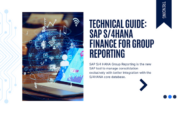SAP ETL
Filter By
Browse By
- SAP Analytics and AI
- SAP Application Development and Integration
- All SAP Application Development and Integration
- SAP ABAP
- SAP ABAP Development Tools
- SAP ABAP Test Cockpit
- SAP API Management
- SAP BAPI
- SAP Basis
- SAP BRF
- SAP Business Application Studio
- SAP CMS
- SAP Design Studio
- SAP Development Tools
- SAP DevOps
- SAP EAI
- SAP EDI
- SAP Extension Suite
- SAP Fiori
- SAP Fiori Elements
- SAP Integration Suite
- SAP Low Code Application Development
- SAP Low Code Automation
- SAP Netweaver
- SAP Release Management
- SAP UI5
- SAP Web Application Server
- SAP Web IDE
- SAP Business Process Management
- SAP Center of Excellence
- SAP CIO
- SAP Customer Experience
- SAP Data and Data Management
- All SAP Data and Data Management
- SAP BW
- SAP BW/4HANA
- SAP Crystal Reports
- SAP Data Archiving
- SAP Data Center
- SAP Data Governance
- SAP Data Integration
- SAP Data Migration
- SAP Data Quality
- SAP Data Services
- SAP Data Strategy
- SAP Data Visualization
- SAP Data Warehouse Cloud
- SAP DMS
- SAP Document Control
- SAP EIM
- SAP ETL
- SAP ETL Tools
- SAP HANA
- SAP HANA Administration
- SAP HANA Deployment Infrastructure
- SAP HANA Studio
- SAP Master Data
- SAP Master Data Governance
- SAP MDM
- SAP Enterprise Architect
- SAP Enterprise Asset Management
- SAP ERP
- SAP Finance
- All SAP Finance
- SAP Accounting
- SAP AR AP
- SAP Asset Accounting
- SAP Billing Systems
- SAP BPC
- SAP BRIM
- SAP Cash Management
- SAP Central Finance
- SAP Controlling
- SAP COPA
- SAP Cost Center Accounting
- SAP Currency Risk
- SAP e-invoicing
- SAP FICO
- SAP Finance Automation
- SAP Advanced Financial Closing
- SAP Financial Consolidation
- SAP Financial Planning
- SAP FX Risk
- SAP General Ledger
- SAP Global Tax Management
- SAP Hyperion
- SAP Order to Cash
- SAP Payment Processing
- SAP Profitability Analysis
- SAP Rebate Management
- SAP S/4HANA Finance
- SAP SWIFT Compliance
- SAP Treasury Management
- SAP Universal Journal
- SAP Governance Risk and Compliance
- SAP Human Capital Management
- SAP Intelligent Technologies
- SAP Platform and Technology
- All SAP Platform and Technology
- SAP Business Technology Platform
- SAP Cloud
- SAP Cloud Connector
- SAP Cloud Integration Platform
- SAP Cloud Migration
- SAP Cloud Platform
- SAP Cloud Providers
- SAP Cloud Strategy
- SAP Digital Signature
- SAP Container Platform
- SAP HANA Enterprise Cloud
- SAP Digital Asset Management
- SAP Smart Forms
- SAP HEC
- SAP Digital Integration Hub
- SAP Hyperscalers
- SAP Infrastructure
- SAP Messaging
- SAP Quality and Testing
- SAP Security
- SAP Spend Management
- SAP Supply Chain Management
- All SAP Supply Chain Management
- SAP APO
- SAP Asset Management
- SAP Business Network
- SAP Digital Manufacturing Cloud
- SAP Digital Twin
- SAP EWM
- SAP IBP
- SAP Inventory Management
- SAP Label Printing
- SAP Logistics
- SAP Manufacturing
- SAP Manufacturing Automation
- SAP MES
- SAP MII
- SAP MM
- SAP MRO
- SAP MRP
- SAP Order Management
- SAP Plant Maintenance
- SAP PLM
- SAP Production Planning
- SAP S&OP
- SAP SD
- SAP SPM
- SAP Supply Chain Planning
- SAP Track and Trace
- SAP Transportation Management
- SAP System Administration
What Is ETL?
ETL (extract, transform, and load) is the process in which the data is extracted from any data sources and transformed into a proper format for storing and future reference purposes. The data is loaded into a database or data warehouse.
What Is SAP ETL?
SAP ETL tools are employed to route data to and from the SAP systems. These tools help to integrate various systems with each other. They can transform different data formats and clean the data by running some checks; for example, by checking if a name value is set. ETL tools can keep the rules on extracting and transforming data outside of an application.
What Is ETL?
ETL (extract, transform, and load) is the process in which the data is extracted from any data sources and transformed into a proper format for storing and future reference purposes. The data is loaded into a database or data warehouse.
What Is SAP ETL?
SAP ETL tools are employed to route data to and from the SAP systems. These tools help to integrate various systems with each other. They can transform different data formats and clean the data by running some checks; for example, by checking if a name value is set. ETL tools can keep the rules on extracting and transforming data outside of an application.
Depending on the data warehousing strategy, you can extract the data from the source and load it into the SAP NetWeaver BW system or directly access the data in the source without storing it physically in the enterprise data warehouse. The data is integrated virtually into the enterprise data warehouse. Sources for the warehouse can be operational, relational datasets, files, or older systems. Transformations enable you to run a technical cleanup and to consolidate the data.
ETL processes to the initial layer in SAP BW as well as direct access to data are possible using various interfaces, depending on the origin and format of the data. SAP BW allows integration of SAP data and non-SAP data.
Further Resources for SAPinsiders:
SAP BusinessObjects Planning and Consolidation: Integrate Jobs into Your Existing Enterprise ETL. In this article, SAP’s Karunakar Gillella describes how to set up controlled batch jobs for SAP BusinessObjects Planning and Consolidation, version for the Microsoft platform, with any corporate scheduling tool.
Another Way to Create an ETL Daily Run Report. Karen Olsen, Business Intelligence Analyst/Developer for W. W. Grainger, shares her success with creating a custom table to track InfoPackages being transported to production. The table provides users with access to accurate information about the status of their jobs.
24 BW Design and Data Modeling Tips for Optimal ETL. In this article, SAP consultants Catherine Roze, Senior BI Consultant, and Joffy Mathew, Senior BW Consultant, provide tips on ETL optimization in six categories: general design and data modeling, PSA design, InfoCube design, ODS design, Dimensions and characteristics design, and aggregates.
193 results
-

Efficient Data Management in Healthcare Using SAP Master Data Governance
Reading time: 9 mins
SAP’s Master Data Governance application provides an integrated data management capability for the creation, maintenance, validation, and distribution of master data across the enterprise. If you already have an SAP ERP system, then adding SAP Master Data Governance accelerates the master data maintenance process, leading to enhanced quality of your master data by leaps and…
-

Leverage Transportation Analytics to Solve the Logistics Puzzle
Reading time: 2 mins
Transportation organizations face pressure to develop lean operations to stand out among a crowded field of competitors, and are continually looking at more efficient ways to keep up with evolving customer demands while providing clear insights into all transportation processes. Keep up with how many organizations are modernizing transportation processes, including leveraging analytics for significant…
-

Ready for Real-Time Business?
Reading time: 2 mins
While many data warehouses are based on a clustered, multi-node system, the new era of real-time business demands less latency and faster transactional workloads. One way to achieve this is by setting up a single-node system that can scale up rather than scale out. New technologies, such as SAP S/4HANA, bring game-changing capabilities and the…
-
-

Capture the Unlimited Potential of SAP HANA in Non-SAP Environments
Reading time: 7 mins
Today’s economy demands data-driven business, the kind that can respond to customer needs quickly and accurately. And for many organizations, this data-driven approach is powered by the agility inherent in the SAP HANA database. Many companies have not yet taken advantage of all SAP HANA has to offer, however, in part because they believe that…
-

Advanced SAP HANA Modeling: How to Use the Query Results Caching Feature to Improve Performance
Reading time: 10 mins
Learn how to best use the query results caching option to improve the performance of your information views. See when to use—or not use—this option as part of your modeled SAP HANA database. Also, learn about other caching topics. Membership Required You must be a member to access this content.View Membership LevelsAlready a member? Log…
-

Columbia Sportswear Connects Active People with Their Passions Faster Than Ever Before
Reading time: 14 mins
To continue to excel in its market, leading outdoor apparel company Columbia Sportswear embarked on an ambitious global business transformation project to modernize its operations and deliver products faster to its customers. Learn how the company automated the conversion of millions of data records from various legacy systems to the SAP Apparel and Footwear industry…
-

Data Can’t Wait: Start Planning Today
Reading time: 14 mins
Since the inception of SAP S/4HANA, one of the main risks that often derails the implementation journey centers around preparing, cleansing, converting, and managing the data. This article presents leading practices that SAP customers can leverage during their SAP S/4HANA implementations to significantly reduce program risks associated with the data conversion process. The advice provided…
-
-

- SAP Financial Consolidation
 Premium
Premium
Working with SAP Group Reporting S/4HANA Finance 2022/2021
Reading time: 21 mins
Solutions like Group Reporting are long-term investments on which improvements are continuously made, unlike products that are in support mode and receive no maintenance support when they reach the end of their life cycle. In this article, you will explore the key functionalities of SAP Group Reporting and the recent new additions to it. Membership…
-

How Endress+Hauser Is Creating a Simpler Business by Making Integration a Strategic Imperative
Reading time: 6 mins
As SAP customers today begin to look more strategically at integration, some are creating centers of excellence dedicated to integration priorities. This case study reveals how one such organization, Endress+Hauser, formed a competency center that focused all the company’s resources and skills around applications integration in one place. Learn how the business moved its integration…
-

- SAP EIM
 Premium
Premium
Hybrid Data Integration and Governance with SAP’s EIM solutions and SAP Data Intelligence
SAP Data Services and SAP Information Steward provide an enterprise-level foundation for ETL and data quality tools. SAP Data Intelligence complements and extends SAP Data Services to enable data orchestration, governance and agile data sharing across on-premise and connected cloud landscapes. Learn about state-of-the-art data integration and governance without reinventing the wheel of SAP EIM…
Become a Member
Unlimited access to thousands of resources for SAP-specific expertise that can only be found here.
Become a Partner
Access exclusive SAP insights, expert marketing strategies, and high-value services including research reports, webinars, and buyers' guides, all designed to boost your campaign ROI by up to 50% within the SAP ecosystem.
Upcoming Events
Related Vendors
Your request has been successfully sent


